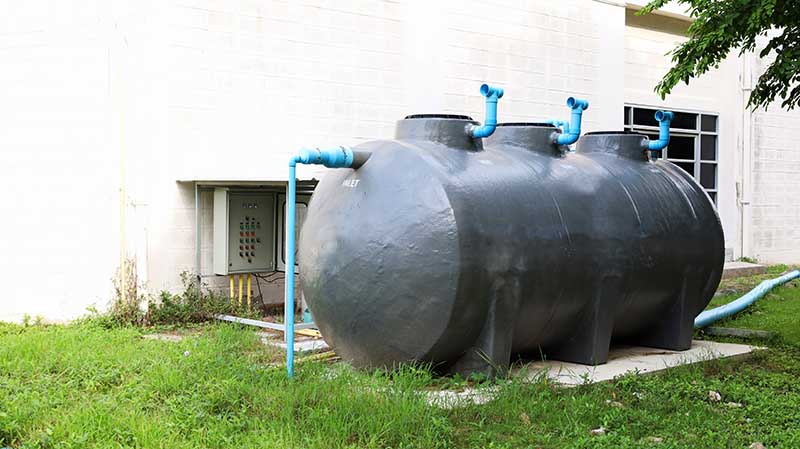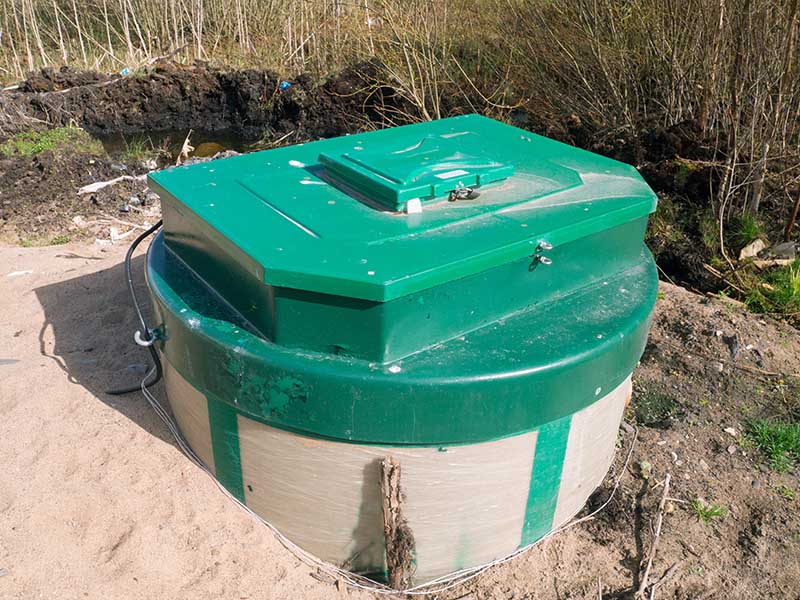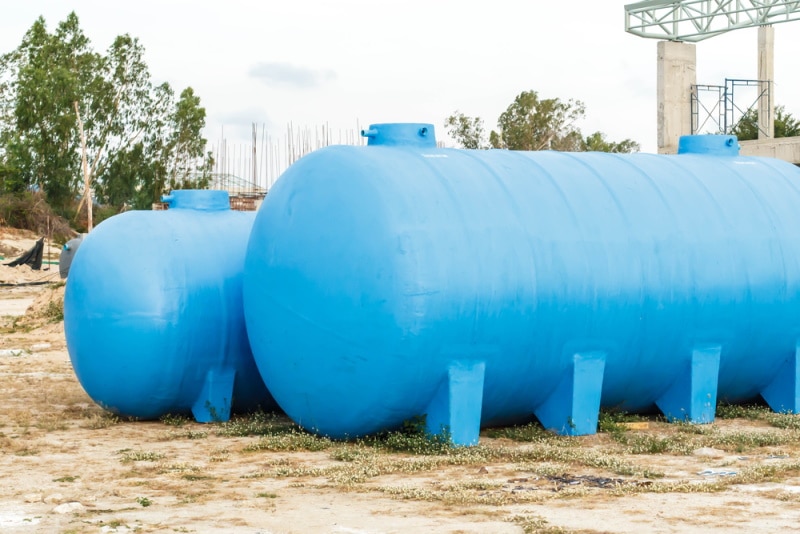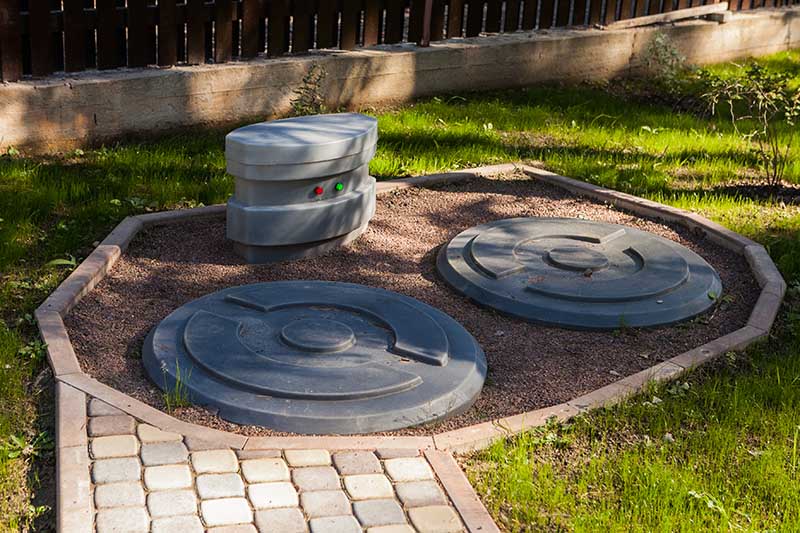Above Ground Septic Tanks: Pros, Cons & Legality
-
Greg Iacono
- Last updated:

Septic systems are a critically important part of many American homes. Most septic systems use tanks buried underground, but this method isn’t feasible or legally allowed in some cases. That’s when an above-ground septic tank is needed. Are you curious about the pros and cons of an above-ground septic tank and any legal issues you might have when you install one? If so, the information below is flush with valuable insights, tips, and more.
How Does It Work?
An above-ground septic tank is similar to a traditional, below-ground septic tank. The tank for both is a large container that acts as a reservoir and holds water, waste, and sewage before it is discharged onto a leach field (aka a discharge area). The most significant and noticeable difference is that above-ground septic tanks are, as the name suggests, above-ground, while traditional septic tanks are placed in a hole in the ground and covered.
Like a traditional septic tank, an above-ground septic tank is a reservoir that does very little except hold your home’s wastewater and sewage. There it sits, and, in time, your home’s solid waste (sludge) separates from your home’s liquid waste (scum). Both the sludge and scum are prevented from leaving the tank so that only water is drained into the drain field next to your septic tank.
However, a leach or drain field might not be possible in the case of an above-ground septic tank due to local laws, ordinances, and other factors. For example, if the water table is too high, as it is in states like Florida, burying a septic tank is impossible, and a leach field would be too close to the underlying water table.
If you need an above-ground septic tank, chances are you’ll also need to hire a professional wastewater removal company to come and drain the tank and remove the sludge and scum regularly. Extra planning and permits are also necessary when installing an above-ground septic tank and system, so a call to your local government office is recommended. Alternatively, you can hire a professional company to help guide you in your particular state and case.
What Are the Different Types of Above-ground Septic Tanks?

Technically, there is only one type of above-ground septic tank that sits on the ground. Above-ground septic tanks are made from different materials, including high-density polyethylene resin, fiberglass, and concrete.
All above-ground septic tanks work the same, do the same job, and, in most cases, must be drained professionally because there’s no leach field where they’re located.
One important thing to note is that some people confuse above-ground septic systems with above-ground septic tanks.
Above-ground systems, also called mound septic systems, use a traditional, below-ground septic tank and have a traditional leach (draining) field. In other words, a mound system doesn’t use an above-ground septic tank and is closer to a conventional septic system.
If you have an RV or a small vacation cottage, there are smaller above-ground septic tanks you can purchase and use. These are so small that they can be moved by hand (if empty) and are used where only a small amount of wastewater and sewage will be generated. As with larger above-ground tanks, a small tank needs to be drained by a professional company. However, since they’re relatively portable, a small above-ground septic tank can also be brought by truck to a sewage collection location for drainage.
The 4 Reasons to Have an Above-Ground Septic Tank
Above-ground septic tanks are used where burying a septic tank underground isn’t feasible or legally allowed. Below are a few examples of locations where an above-ground tank is usually needed for your septic system.
1. Your Property Is on the Waterfront
Because waterfront property is usually at sea level, the water table under the ground is relatively high. For this reason, burying a septic tank underground would be almost impossible. If there were a leak of any kind, it would go directly into the surrounding groundwater, creating an unhealthy situation for your family and your neighbors.
2. Burying a Septic Tank Is Illegal in Your Location

Because of protection from the Environmental Protection Agency of the United States (the US EPA), it’s illegal to bury a septic tank on most waterfront property. That’s because, with a buried tank, you usually have a leach field, and when you’re close to the water table, a leach field can be very unsafe for you, your family, and the surrounding environment. Also, a septic tank can leak, which would cause similar problems.
3. The Cost of Burying a Tank Would Be Prohibitive
If, for example, you have a cabin far out in the forest, digging a hole for a septic tank might not be feasible. In that case, an above-ground septic tank would be a better, more affordable option.
4. The Soil Is Too Caustic
Although it’s not an extensive problem in the US, some places have soil that’s harmful, unstable, or otherwise not optimal for burying a septic tank. Very acidic soil, for example, can quickly burn through concrete, plastic, and fiberglass and cause unhealthy sewage leaks. Also, unstable ground can risk damage to the septic tank if the tank moves, which can cause leaks.
Advantages of Above-ground Septic Tanks
- They can be placed where buried tanks are illegal.
- Above-ground tanks protect the surrounding water table from contamination.
- They can be placed where burying a septic tank is not feasible or affordable.
- They often last longer as they aren’t exposed to elements in the ground that damage them or wear them out.
- Fixing or repairing an above-ground septic tank is typically easier and faster than a buried tank.
Disadvantages of Above-ground Septic Tanks
- You can see them, which can be unsightly in some cases, depending on where the tank is located in your yard.
- Above-ground septic tanks need to be drained regularly by a professional company.
Frequently Asked Questions

What’s the difference between an above-ground septic tank and a mound septic system?
A mound septic system uses a traditional, below-ground septic tank and a leach field. An above-ground septic tank is always above-ground and usually doesn’t have a leach field.
Do above-ground septic tanks work differently than traditional, buried septic tanks?
No, they function exactly the same way. Both tanks separate the sludge and scum in your home’s wastewater so they can be taken away safely. The only difference is that above-ground septic tanks don’t use a leach field but must be professionally drained.
What types of materials are used to make above-ground septic tanks?
Most above-ground septic tanks are made from high-density polyethylene resin, fiberglass, or concrete.
Can above-ground septic tanks be used near the waterfront?
In most cases, yes, but there are typically many rules and regulations that must be followed before you’re allowed to place one on your property.
Are above-ground septic tanks an eyesore?
That depends on where you locate them, how much land you have, etc. When possible, an above-ground septic tank can be placed in an area of your property where it’s out of sight.
Does an above-ground septic tank last longer?
Depending on the weather and other factors, an above-ground septic tank will often outlast a buried tank.
A Quick Reference Guide
| When to Use a Traditional, Buried Septic Tank | When to Use an Above-ground Septic Tank | |
| Regular subdivision | Yes | No |
| Home is connected to the sewage system | Yes | No |
| Waterfront property | No | Yes |
| Water table is high | No | Yes |
| Forest cabin | No | Yes |
| Buried tank is illegal | No | Yes |
| Leach field is illegal | No | Yes |
Final Thoughts
If your home isn’t connected to a sewage network, you’ll need a septic system, and if a buried tank or leach field isn’t allowed, you’ll need an above-ground septic tank. Above-ground septic tanks work exactly like traditional, buried tanks, separating solid and liquid waste and allowing them to be taken away without harming the environment.
The most significant difference you’ll find with an above-ground septic tank is that it needs to be regularly and professionally drained, whereas a traditional, buried tank drains into its leach field. Aside from this extra expense, an above-ground tank can also be a bit of an eyesore, depending on where it needs to be placed on your property. Either system, when maintained properly, will safely dispose of your home’s wastewater for many years.
Featured Image Credit: kaninw, Shutterstock
Contents



